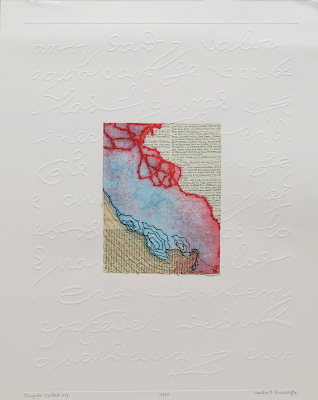Testimonios Through Creative Acts
Sandra Fernandez, Cruzado (Settled In) 2015
Redlining was my first thought when I looked at this piece. Some might think that 2020 ushered in mayhem that highlighted every crack in our country's foundation but I disagree. We were already there. In the middle of COVID, the weight of social justice inequalities weighed heavily and everything came to a head when George Floyd was killed. And Breonna Taylor. And Elijah McClain. And Adam Toledo.
Redlining is a discriminatory practice in which services are withheld from potential customers who reside in neighborhoods classified as 'hazardous' to investment; these neighborhoods have significant numbers of racial and ethnic minorities, and low-income residents. There are so many perspectives and ways in which to discuss systemic inequalities. In this post, I will only discuss redlining as it relates to what is happening in Dallas County, approximately one hour away from where I live. Dallas County is a "blue county" on paper. However, when the sun goes down, there are certain neighborhoods that one doesn't travel through alone if at all. Forget being LGBTQ+, young or old or disabled. It is a race issue first and foremost.
In Southern Dallas County, home of the iconic State Fair of Texas, several blue ribbon public schools and historically designated neighborhoods sits a portion of the county that has long been forgotten. The low-income, poverty level community largely resides in this area. Splitting the north from the south is the Hunt-Hill Bridge. If you travel from Austin and want to go through Dallas to Oklahoma or further, you can't miss it. Middle to upper class and celebrities all live north of the bridge. On every other block there are grocery, retail, financial institutions, entertainment, beautiful parks and recreation spaces, ample sidewalks and public bus routes.
The joke in DFW is "this is the bridge to nowhere". It is not necessary and blocks the view of the Dallas Skyline for many.
When you go to South Dallas, in some spaces, to get to the bus, you have to walk in the grass on occasion or along the side of the road. This is often littered with beer cans, needles, trash or other remnants of a good time. There are no true banks. There are fewer than five and though they will take a deposit or offer a credit card application, they won't issue loans. Grocery stores aren't on every other block and housing is Section 8 or it has been in the family and has seen better days. The majority of people living in this part of the county are Black or Latino.
The wealth disparity between POC and white families is deeply rooted in marginalization within the housing market. In the US, where homeownership makes a difference in terms of social and class, POC and their lack of access are at a disadvantage, thus, leading to food scarcity or insecurity, lack of access to affordable higher education, etc.
The artwork for me intersects with how Anzaldua describes the geopolitical U.S./Mexico borderlands as a "third country" that is a specific place that has been, like other borders, "set up to define the places that are safe and unsafe, to distinguish us from them."
Anzaldua, G. (1999). Borderlands: la frontera: The new mestia. San Francisco, CA: Aunt Lute Books.
Immigrants are not to be feared. The faces in this piece do not look like one's I would fear. Similarly, those in South Dallas County should not be feared by the corporate community - banks, grocery stores, retail. The red cardinal is a symbol of love, faith and hope. Love thy neighbor as thyself.
"The Mexico U.S. border is a site where many different cultures “touch” each other, and the permeable, flexible, ambiguous shifting grounds lend themselves to hybrid images. Border artistas cambian el punto de referencia. By disrupting the neat separations between cultures, they create a culture mix, una mes tizada in their artworks."
To me, this depicts exactly what is happening in Dallas County. There are borders within borders (county lines).
APA 7th Edition (American Psychological Assoc.)
Gloria Anzaldua, & AnaLouise Keating. (2015). Light in the Dark/Luz En Lo Oscuro : Rewriting Identity, Spirituality, Reality. Duke University Press Books.


Comments
Post a Comment